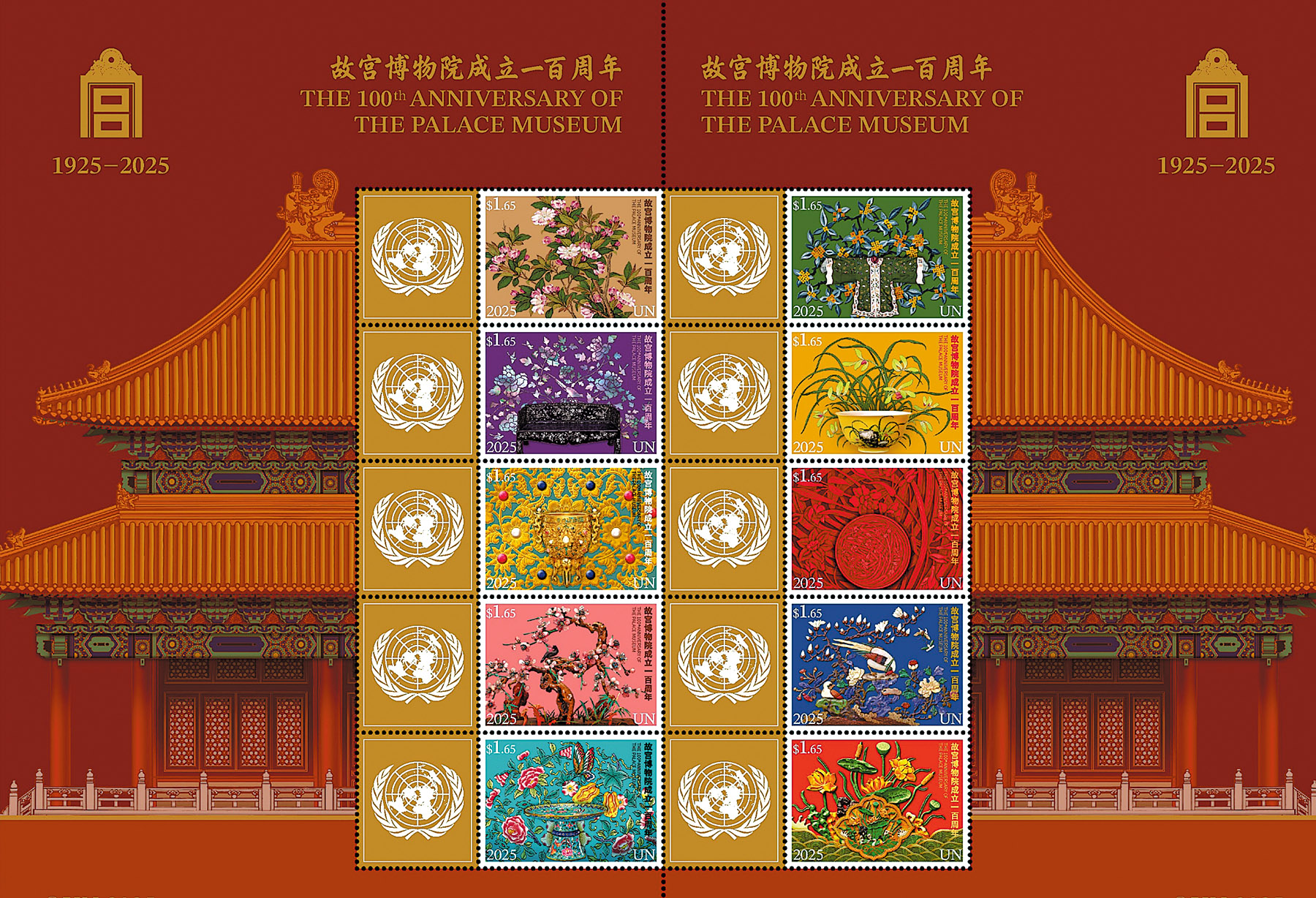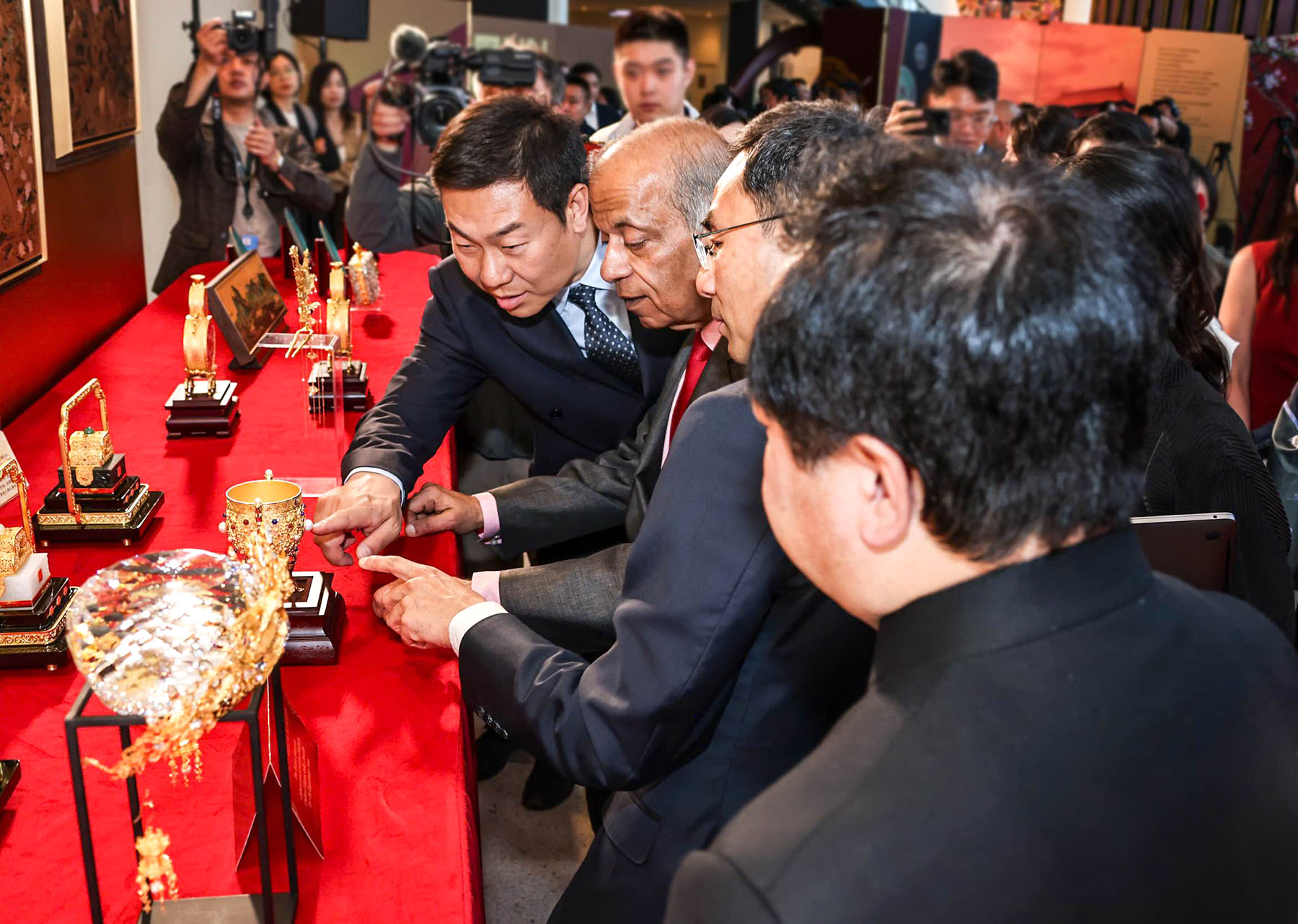
From delicate crab apple blossoms to fragrant osmanthus, floral motifs from centuries-old artifacts in the Palace Museum have found new life, not on porcelain or silk, but on postage stamps.
To celebrate the museum's centenary and International Museum Day, the United Nations Postal Administration recently issued a sheet of 10 commemorative stamps — each valued at $1.65 — marking the first time the administration has released a special event sheet stamp for a single museum.
All the stamps feature floral designs inspired by the museum's artifacts or architecture. For instance, the crab apple blossom motif of one stamp is derived from an album of flowers and birds painted by Qing Dynasty (1644-1911) court artist Yu Zhi, while the red narcissus design of the stamp comes from a Yuan Dynasty (1271-1368) plate adorned with the same pattern. The interleaving paper beneath the 10 stamps depicts the Gate of Divine Prowess (Shenwu Men) of the Forbidden City, rendered in red, a dominant color in the palace's architectures.
READ MORE: UN releases Palace Museum centennial stamps
Wu Di, head of the Palace Museum's cultural and creative products department, tells China Daily that only 16,800 sets of the stamps have been issued. A small portion will be sold at the museum's cultural store for 698 yuan ($96.9) per set, while the majority are being distributed overseas.
The choice of flowers as the stamp theme symbolizes the flourishing diversity of China's traditional culture and hopes for its global reach. "Stamps, as tiny cultural ambassadors, can convey such beautiful meanings," says Wu.
Interestingly, one of the flowers featured on the stamps is not found in nature. The baoxiang hua (auspicious flowers), a fictional and hybrid floral design found on Jin'ou Yonggu Cup (Gold Cup with "Everlasting Territory" Inscription), a wine vessel exclusively used by the emperors for worship during a special New Year's Day ceremony.
"The baoxiang hua combines elements from peonies, chrysanthemums and lotuses. The cup features 36 such flowers, symbolizing the 360-some days of a full year — representing peace and prosperity," Wu explains.
He reveals that two designers have worked on polishing drafts for the stamp design over a couple of months, and one of their biggest challenges was capturing the exquisite details and vibrant colors of the artifacts on such a small canvas.
"The Palace Museum's collections are extraordinary — diverse in variety, exceptional in quality, and immense in historical and social value," Wu says.

With over 20,000 sets of cultural and creative products already developed for cultural products, selecting artifacts for the stamp designs felt like exploring a vast treasure trove.
Highlighting museums' pivotal role in conserving and promoting humanity's cultural heritage, he adds that creative products like these stamps inspired by museum collections carry profound significance.
A native of Northeast China's Liaoning province, Wu has been a stamp collector since childhood, fostering a deep passion for philately. Three years ago, when he first joined the museum's cultural and creative department, he participated in the launch of a Chinese zodiac stamp series for the Year of the Rabbit.
The stamps, featuring Tu'er Ye, a rabbit with a human body adorned in the attire of an ancient general, were designed by Zhang Chang, a professor at Tsinghua University's Academy of Arts and Design and a fourth-generation inheritor of the Niren Zhang Family, renowned for their exquisitely crafted clay figurines. Sadly, Zhang passed away from illness before completing the design, leaving a poignant backstory of the stamps.
The stamp launch was held in the UN's New York headquarters on May 19, along with an exhibition to showcase the Palace Museum's cultural and creative products that drew over 120 ambassadors and representatives of UN agencies.
ALSO READ: Palace Museum bridging civilizations
Wang Yuegong, deputy director of the Palace Museum, says that the museum is committed to prioritizing artifact conservation and exploring their cultural value, with its goal to transform the 600-year-old Forbidden City's heritage into a driving force for global cultural exchange in the new era.
The exhibition, which draws inspiration from a philosophical concept in the ancient Chinese classic I Ching (Book of Changes)-"the mutual growth and endless continuity of all things" — also showcases the museum's initiatives in diverse fields, including accessibility for people with disabilities, rural revitalization and environmental protection.
The products on display range from small bags to silk scarves. Some are crafted from recycled materials, such as plastic bottles, Wu says.
The museum opened a special hall to better serve visitors with disabilities in December last year, where people can experience architectural models and artifacts through touch, sound and scent.
Contact the writer at xufan@chinadaily.com.cn


